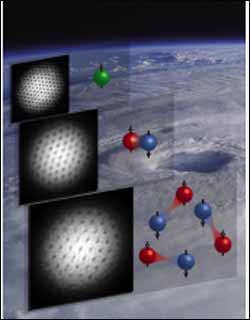MIT Group Creates a High-Temperature Superfluid

The vortices observed in three rotating superfluids superimposed on the eye of a hurricane
Physicists at the Massachusetts Institute of Technology (MIT) have created the first example of a high-temperature superfluid: a new state of matter in which the atoms in a gas can move with no friction or slowing down whatsoever.
Reported in the June 23 issue of journal Nature, the work is closely related to the superconductivity of electrons in metals. According to Wolfgang Ketterle, the Nobel laureate who heads the MIT group, observations of superfluids may help solve lingering questions about high-temperature superconductivity, which has widespread applications for magnets, sensors and energy efficient transport of electricity.
“In superfluids, as well as in superconductors, particles move in lockstep,” explains Ketterle. “They form one big quantum-mechanical wave.” Such a movement allows superconductors to carry electrical currents without resistance.
The MIT research was carried out at the MIT-Harvard Center for Ultracold Atoms, which is funded by the National Science Foundation (NSF), and received direct support from NSF, the Office of Naval Research, the National Aeronautics and Space Administration, and the Army Research Office.
For more information, see the MIT news release.
Media Contact
All latest news from the category: Physics and Astronomy
This area deals with the fundamental laws and building blocks of nature and how they interact, the properties and the behavior of matter, and research into space and time and their structures.
innovations-report provides in-depth reports and articles on subjects such as astrophysics, laser technologies, nuclear, quantum, particle and solid-state physics, nanotechnologies, planetary research and findings (Mars, Venus) and developments related to the Hubble Telescope.
Newest articles

Sea slugs inspire highly stretchable biomedical sensor
USC Viterbi School of Engineering researcher Hangbo Zhao presents findings on highly stretchable and customizable microneedles for application in fields including neuroscience, tissue engineering, and wearable bioelectronics. The revolution in…

Twisting and binding matter waves with photons in a cavity
Precisely measuring the energy states of individual atoms has been a historical challenge for physicists due to atomic recoil. When an atom interacts with a photon, the atom “recoils” in…

Nanotubes, nanoparticles, and antibodies detect tiny amounts of fentanyl
New sensor is six orders of magnitude more sensitive than the next best thing. A research team at Pitt led by Alexander Star, a chemistry professor in the Kenneth P. Dietrich…





















